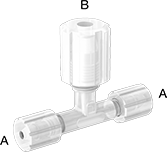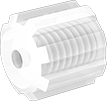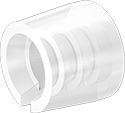How to Identify and Measure Fittings
Pipe size is an industry designation, not the actual size. View information about how to measure threaded and unthreaded pipe and pipe fittings.
More
High-Temperature PTFE Pipe Fittings for Chemicals
Extreme temperatures are no problem for these fittings—they’re made of PTFE, so they can withstand a wider temperature range than any of our other plastic pipe fittings for chemicals. They have the chemical resistance to stand up to acid and solvents. Fittings have thick, Schedule 80 walls for heavy duty industrial applications. The material won’t leach contaminates into the line, so these fittings are commonly used in high-purity processes, such as semiconductor and clean room applications. They have a super-smooth interior for unrestricted flow. Apply a non-hardening, plastic-compatible sealant to the male threads to prevent leaks. Tape or sealants with PTFE are not recommended for plastic-to-plastic threaded connections. When making a threaded connection be careful not to overtighten the threads. To prevent cracks and leaks, finger tighten the fitting, then wrench-tighten one to two turns. Fittings meet ASTM D1710 specifications and testing requirements for material quality.
Warning: Never use plastic pipe fittings and pipe with compressed air or gas.
Sealants cannot be sold to Colorado, Connecticut, District of Columbia, Delaware, Illinois, Indiana, Massachusetts, Maryland, Maine, Michigan, New Hampshire, New Jersey, Northern Virginia, New York, Ohio, Pennsylvania, Rhode Island, or Utah due to local VOC (Volatile Organic Compounds) regulations.
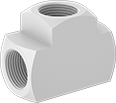
- For Use With: Deionized Water, Hydrochloric Acid, Solvents
- Temperature Range: -450° to 550° F
- Specifications Met: ASTM D1710
- Pipe Nipples and Pipe: Use Schedule 80 PTFE Plastic
- Flanges: Use Class 150 PTFE Plastic
| Pipe Size | Material | Color | Max. Pressure | Each | |
NPT Threads | |||||
|---|---|---|---|---|---|
| 1/8 | PTFE Plastic | White | 110 psi @ 72° F | 000000000 | 000000 |
| 1/4 | PTFE Plastic | White | 90 psi @ 72° F | 000000000 | 00000 |
| 3/8 | PTFE Plastic | White | 60 psi @ 72° F | 000000000 | 00000 |
| 1/2 | PTFE Plastic | White | 60 psi @ 72° F | 000000000 | 00000 |
| 3/4 | PTFE Plastic | White | 50 psi @ 72° F | 000000000 | 000000 |
| 1 | PTFE Plastic | White | 35 psi @ 72° F | 000000000 | 000000 |
| Non-Hardening Thread Sealant (8-oz. Brush-Top Can) | 000000 | Each | 000000 |
Brass Push-to-Connect Fittings for Food, Beverage, and Dairy

- Temperature Range: 5° to 370° F
- Tubing: Use with FEP, Nylon, Polyethylene, or PTFE Plastic
- Specifications Met:
Brass Fittings: NSF/ANSI 169, EC Regulation 1935/2004, DM 174/2004
Nickel-Plated Brass Fittings: NSF/ANSI 169
Made of brass, these fittings withstand frequent washdowns in food-processing applications. They also adhere to NSF/ANSI safety standards, so they’re safe to use with food, beverages, and dairy. Also known as instant fittings, they connect to plastic tubing with a push, and an internal gripping ring and O-ring hold the tubing tight. To disconnect them, push the release ring and pull the tubing out of the fitting.
Unplated brass fittings meet European Union standards for food safety and Italian standards for drinking water.
Nickel-plated brass fittings have better corrosion resistance than brass fittings that aren’t plated.
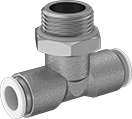
Fittings with intermittent swivel rotate 360° to prevent kinking and allow systems to move.
Inline tees are also known as branch tees.
Release Ring | Brass | Nickel-Plated Brass | ||||||
|---|---|---|---|---|---|---|---|---|
| For Tube OD, mm | Pipe Size | Material | Color | Max. Pressure | Each | Each | ||
BSPP Threads | ||||||||
| 4 | 1/8 | Plastic | White | 290 psi @ 72° F | 00000000 | 00000 | 0000000 | 00000 |
| 6 | 1/8 | Plastic | White | 290 psi @ 72° F | 00000000 | 00000 | 0000000 | 0000 |
| 6 | 1/4 | Plastic | White | 290 psi @ 72° F | 000000 | 00 | 0000000 | 0000 |
| 8 | 1/8 | Plastic | White | 290 psi @ 72° F | 000000 | 00 | 0000000 | 0000 |
| 8 | 1/4 | Plastic | White | 290 psi @ 72° F | 00000000 | 00000 | 0000000 | 0000 |
| 8 | 3/8 | Plastic | White | 290 psi @ 72° F | 0000000 | 00000 | 000000 | 00 |
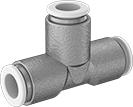
Release Ring | Brass | Nickel-Plated Brass | |||||
|---|---|---|---|---|---|---|---|
| For Tube OD, mm | Material | Color | Max. Pressure | Each | Each | ||
| 4 | Plastic | White | 290 psi @ 72° F | 00000000 | 00000 | 0000000 | 00000 |
| 6 | Plastic | White | 290 psi @ 72° F | 00000000 | 0000 | 0000000 | 0000 |
| 8 | Plastic | White | 290 psi @ 72° F | 00000000 | 0000 | 0000000 | 0000 |
| 10 | Plastic | White | 290 psi @ 72° F | 000000 | 00 | 0000000 | 00000 |
| 12 | Plastic | White | 290 psi @ 72° F | 000000 | 00 | 0000000 | 00000 |
High-Temperature Push-to-Connect Fittings for Food, Beverage, and Dairy

- Temperature Range: 5° to 280° F
- Tubing: Use with FEP, Nylon, Polyethylene, or PTFE Plastic
- Specifications Met: NSF/ANSI 169, EC Regulation 1935/2004, DM 174/2004
Connect hot food and beverage lines with just a push. Also known as instant fittings, they have an internal gripping ring and an O-ring that hold tight to tubing. To disconnect the fittings, push the release ring and pull the tubing out of the fitting. They meet U.S. and European Union standards for food safety and Italian standards for drinking water.
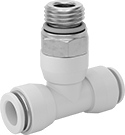
Inline tees are also known as branch tees.
Release Ring | 316 Stainless Steel Sleeve | ||||||
|---|---|---|---|---|---|---|---|
| For Tube OD, mm | Pipe Size | Material | Material | Color | Max. Pressure | Each | |
BSPP Threads | |||||||
| 4 | 1/8 | PPSU Plastic | Plastic | White | 290 psi @ 72° F | 0000000 | 000000 |
| 4 | 1/4 | PPSU Plastic | Plastic | White | 290 psi @ 72° F | 0000000 | 00000 |
| 6 | 1/8 | PPSU Plastic | Plastic | White | 290 psi @ 72° F | 0000000 | 00000 |
| 6 | 1/4 | PPSU Plastic | Plastic | White | 290 psi @ 72° F | 0000000 | 00000 |
| 8 | 1/4 | PPSU Plastic | Plastic | White | 290 psi @ 72° F | 0000000 | 00000 |
| 8 | 3/8 | PPSU Plastic | Plastic | White | 290 psi @ 72° F | 0000000 | 00000 |
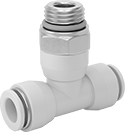
Inline tees are also known as branch tees. Fittings with intermittent swivel rotate 360° before and after installation as needed to allow movement in the system and to prevent kinking.
Release Ring | Brass Sleeve | ||||||
|---|---|---|---|---|---|---|---|
| For Tube OD, mm | Pipe Size | Material | Material | Color | Max. Pressure | Each | |
BSPP Threads | |||||||
| 4 | 1/8 | PPSU Plastic | Plastic | White | 290 psi @ 72° F | 0000000 | 000000 |
| 4 | 1/4 | PPSU Plastic | Plastic | White | 290 psi @ 72° F | 0000000 | 00000 |
| 6 | 1/8 | PPSU Plastic | Plastic | White | 290 psi @ 72° F | 0000000 | 00000 |
| 6 | 1/4 | PPSU Plastic | Plastic | White | 290 psi @ 72° F | 0000000 | 00000 |
| 8 | 1/4 | PPSU Plastic | Plastic | White | 290 psi @ 72° F | 0000000 | 00000 |
| 8 | 3/8 | PPSU Plastic | Plastic | White | 290 psi @ 72° F | 0000000 | 00000 |
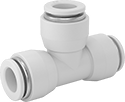
Release Ring | Brass Sleeve | 316 Stainless Steel Sleeve | ||||||
|---|---|---|---|---|---|---|---|---|
| For Tube OD, mm | Material | Material | Color | Max. Pressure | Each | Each | ||
| 4 | PPSU Plastic | Plastic | White | 290 psi @ 72° F | 0000000 | 00000 | 0000000 | 000000 |
| 6 | PPSU Plastic | Plastic | White | 290 psi @ 72° F | 0000000 | 00000 | 0000000 | 00000 |
| 8 | PPSU Plastic | Plastic | White | 290 psi @ 72° F | 0000000 | 00000 | 0000000 | 00000 |
Compression Fittings for Plastic Tubing—Chemicals
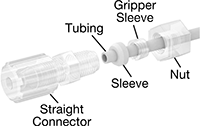
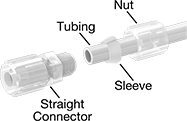
- For Use With: PFA Plastic: Hydrochloric Acid, Sulfuric Acid
PTFE Plastic: Alcohol, Ammonia, Benzoic Acid, Bleach, Bromine, Coolant, Fluoboric Acid, Hydrochloric Acid, Hydrofluoric Acid, Nitric Acid, Organic Solvents, Sodium Carbonate, Sulfuric Acid - Temperature Range: PFA Plastic: 0° to 350° F
PTFE Plastic: -40° to 185° F - Tubing: PFA Plastic: Use with hard (Durometer 50D-65D) PFA or PTFE plastic
PTFE Plastic: Use with hard (Durometer 60D) PFA or PTFE plastic
A sleeve (ferrule) compresses the tubing as you tighten the nut, creating a strong seal. The nut and sleeve are included. Fittings are also known as flareless fittings. Fittings that include a gripper sleeve on the tubing create an even tighter seal.
PFA fittings stand up to harsh substances. They’re made through a melting process. PTFE fittings are highly resistant to most acids, alcohols, detergents, and solvents. They’re made by machining. Their nut is made of PVDF, which is resistant to halogens such as chlorine and bromine, strong acids such as hydrofluoric and nitric acids, and organic solvents.

Inline tees are also known as branch tees.
| For Tube OD | Pipe Size | Material | Color | Max. Pressure | Each | |
NPT Threads | ||||||
|---|---|---|---|---|---|---|
| 1/8" | 1/8 | PFA Plastic | White | 120 psi @ 72° F | 00000000 | 0000000 |
| 1/8" | 1/4 | PFA Plastic | White | 125 psi @ 72° F | 000000000 | 000000 |
| 1/4" | 1/8 | PFA Plastic | White | 120 psi @ 72° F | 00000000 | 000000 |
| 1/4" | 1/4 | PFA Plastic | White | 120 psi @ 72° F | 00000000 | 000000 |
| 3/8" | 1/4 | PFA Plastic | White | 120 psi @ 72° F | 000000000 | 000000 |
| 3/8" | 3/8 | PFA Plastic | White | 120 psi @ 72° F | 00000000 | 000000 |
| 3/8" | 1/2 | PFA Plastic | White | 120 psi @ 72° F | 000000000 | 000000 |
| 1/2" | 1/4 | PFA Plastic | White | 120 psi @ 72° F | 000000000 | 000000 |
| 1/2" | 1/2 | PFA Plastic | White | 120 psi @ 72° F | 000000000 | 000000 |
| 3/4" | 3/4 | PFA Plastic | White | 120 psi @ 72° F | 00000000 | 000000 |
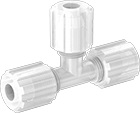
| For Tube OD | Material | Color | Max. Pressure | Each | |
| 1/8" | PFA Plastic | White | 120 psi @ 72° F | 00000000 | 0000000 |
| 1/4" | PFA Plastic | White | 120 psi @ 72° F | 00000000 | 000000 |
| 3/8" | PFA Plastic | White | 120 psi @ 72° F | 00000000 | 000000 |
| 1/2" | PFA Plastic | White | 120 psi @ 72° F | 00000000 | 000000 |
| 3/4" | PFA Plastic | White | 120 psi @ 72° F | 00000000 | 000000 |
| 4mm | PTFE Plastic | White | 100 psi @ 72° F | 000000000 | 000000 |
| 6mm | PTFE Plastic | White | 100 psi @ 72° F | 000000000 | 000000 |
| 8mm | PTFE Plastic | White | 100 psi @ 72° F | 000000000 | 000000 |



























